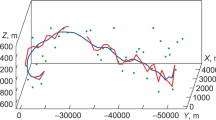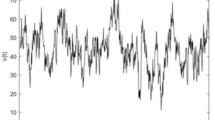Abstract
The error of the conventional sculling correction algorithm under maneuvers is analyzed through Taylor series expansion; a generalized error equation is presented. Using frequency-series sculling algorithms in the digital algorithm for the velocity translation vector will cause the accuracy of the digital algorithm under maneuvers to decrease by one order in iteration time interval. Some New sculling algorithms are developed and evaluated, which are as accurate as frequency-series sculling algorithms under vibrations, and are at least one order more accurate than frequency-series algorithms under maneuvers. Several new digital algorithms are constructed with the presented sculling algorithms for the velocity translation vector, which avoids the loss in accuracy of velocity translation vector under maneuvers. Simulations agree well with the analytical results.
Similar content being viewed by others
References
Savage P G. A unified mathematical framework for strapdown algorithm design. J Guid Control Dyn, 2006, 29: 237–249
Ignagni M B. Duality of optimal strapdown sculling and coning compensation algorithms. J Inst Navig, 1998, 45: 85–95
Miller R. A new strapdown attitude algorithm. J Guid Control Dyn, 1983, 6: 287–291
Savage P G. Strapdown inertial navigation system integration algorithm design, part 1: attitude algorithms. J Guid Control Dyn, 1998, 21: 19–28
Ignagni M B. Optimal strapdown attitude integration algorithms. J Inst Navig, 1990, 13: 363–369
Ignagni M B. Efficient class of optimized coning compensation algorithms. J Inst Navig, 1996, 19: 424–429
Park C G, Kim K J. Formalized approach to obtaining optimal coefficients for coning algorithms. J Guid Control Dyn, 1999, 22: 165–168
Savage P G. Coning algorithm design by explicit frequency shaping. J Guid Control Dyn, 2010, 33: 1123–1132
Roscoe K M. Equivalency between strapdown inertial navigation coning and sculling integrals/algorithms. J Guid Control Dyn, 2001, 24: 201–205
Savage P G. Strapdown inertial navigation system integration algorithm design, part 2: velocity and position algorithms. J Guid Control Dyn, 1998, 21: 208–221
Savage P G. Explicit frequency-shaped coning algorithms for pseudo coning environments. J Guid Control Dyn, 2011, 34: 774–782
Author information
Authors and Affiliations
Corresponding author
Rights and permissions
About this article
Cite this article
Song, M., Wu, W. A new digital algorithm for the velocity translation vector. Sci. China Inf. Sci. 56, 1–13 (2013). https://doi.org/10.1007/s11432-012-4758-5
Received:
Accepted:
Published:
Issue Date:
DOI: https://doi.org/10.1007/s11432-012-4758-5




